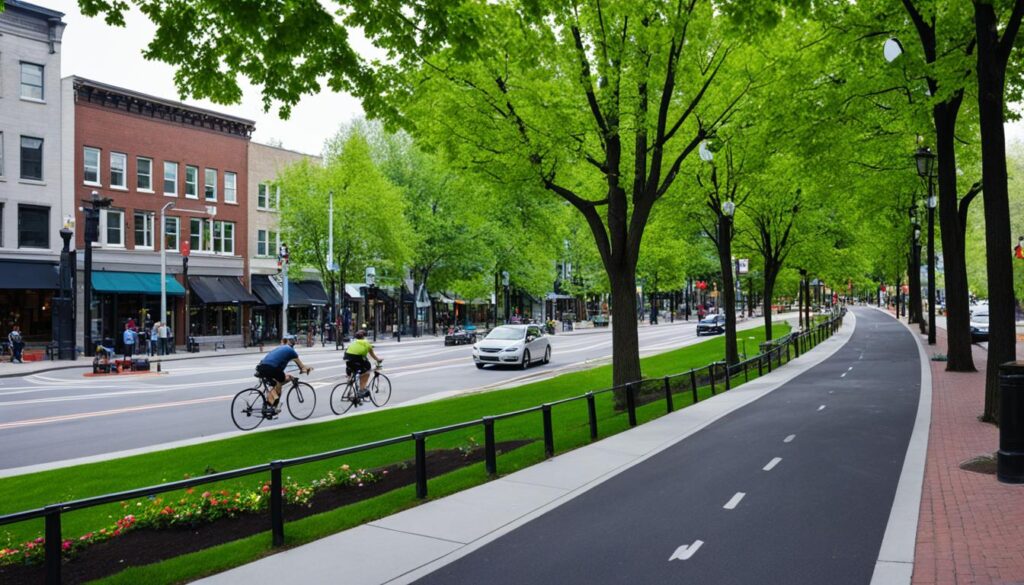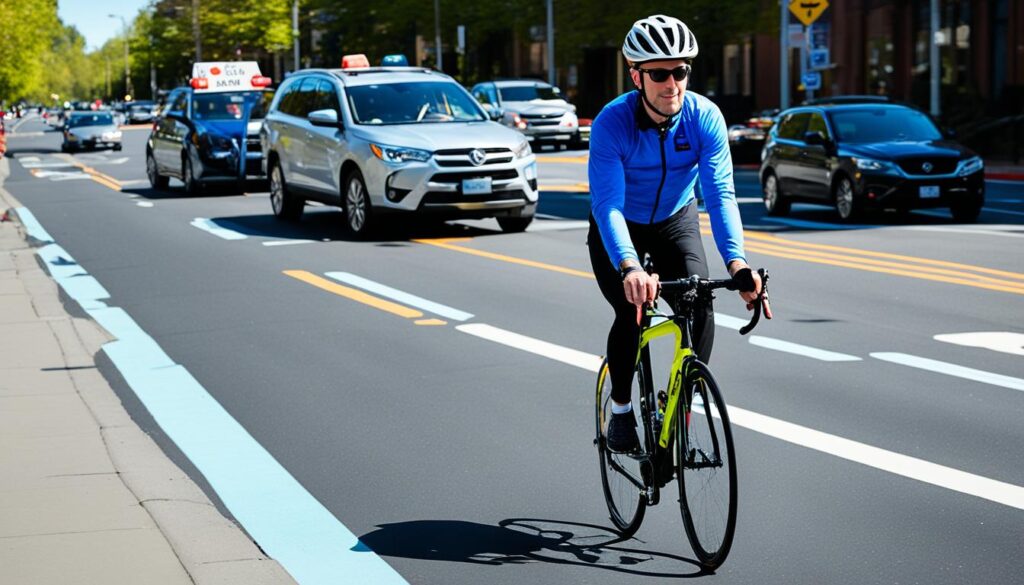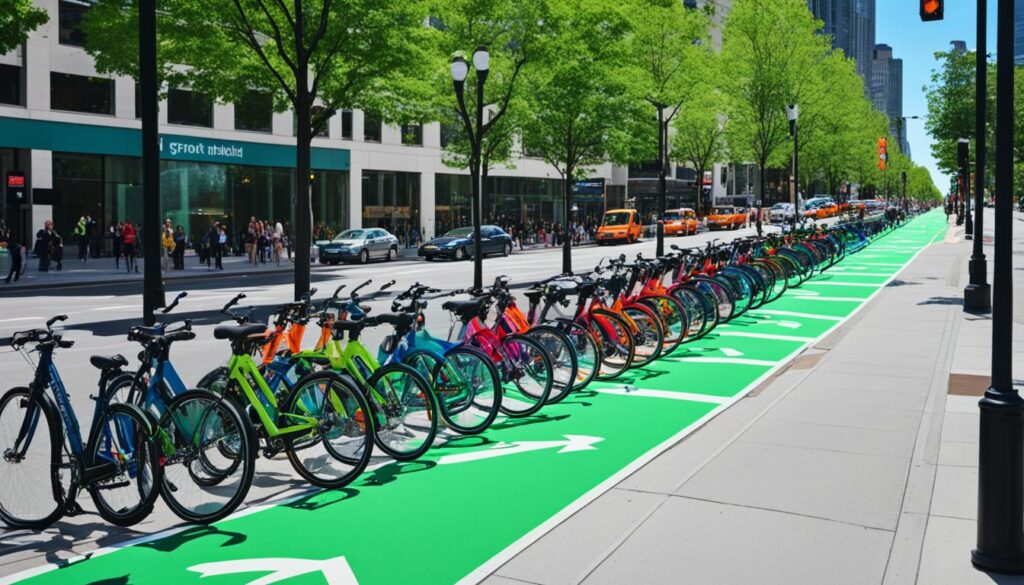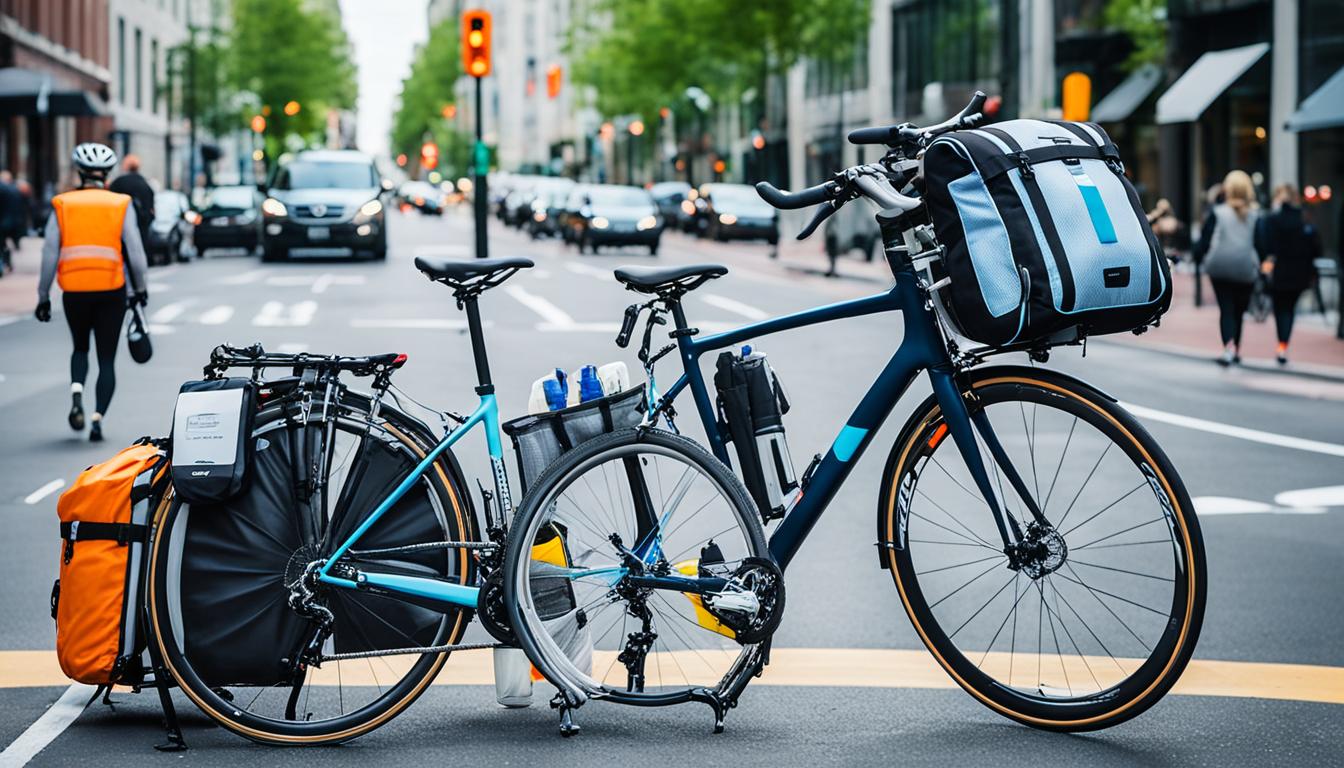Are you tired of getting stuck in traffic or spending a fortune on gas? Looking for an eco-friendly alternative that also keeps you fit and healthy? Have you ever considered bike commuting?
Cycling to work is not only a practical mode of transportation, but it also offers a plethora of benefits for both individuals and the environment. With the growing popularity of bike-friendly cities, dedicated bike lanes, and improved cycling infrastructure, bike commuting is on the rise. But how do you make the most of your bike commute? And what gear do you need to ensure a safe and comfortable journey?
Key Takeaways:
- Bike commuting is an eco-friendly and cost-effective way to get to work.
- It offers numerous health benefits and helps reduce traffic congestion and air pollution.
- Essential gear for bike commuting includes bike lights, locks, panniers, helmets, and reflective clothing.
- Choosing the right bike for commuting depends on personal preferences and specific commuting needs.
- Planning your bike route and prioritizing safety is crucial for a successful bike commute.
In this article, we will delve into the world of bike commuting, sharing valuable tips and discussions to help you unlock the secrets to a greener and healthier commute. From selecting the right gear to planning your route and navigating different weather conditions, we’ve got you covered. So, saddle up and join us on this exciting journey!
Why Bike Commuting?

Bike commuting offers a myriad of benefits for individuals and the environment. Embracing cycling as a mode of transportation not only provides a convenient and efficient way to get to work but also brings a host of advantages that can positively impact your health, the environment, and your wallet.
Health Benefits of Cycling
Cycling for transportation is an excellent way to incorporate physical exercise into your daily routine.
Regular cycling can improve cardiovascular fitness, strengthen muscles, and enhance flexibility and coordination. It also helps to maintain a healthy weight and reduce the risk of chronic diseases such as heart disease, obesity, and diabetes. And let’s not forget the mental health benefits — cycling has been proven to boost mood, reduce stress, and improve overall well-being.
Environmental Benefits of Cycling
Bike commuting is a sustainable and eco-friendly transportation option.
By choosing to cycle instead of driving a car, you can significantly reduce your carbon footprint. Bicycles produce zero emissions, helping to combat air pollution and mitigate the effects of climate change. Additionally, bike commuting contributes to reducing traffic congestion, making cities cleaner, quieter, and more livable.
Cost Savings of Bike Commuting
Say goodbye to exorbitant fuel prices and costly maintenance fees.
Bike commuting offers substantial cost savings compared to traditional modes of transportation. With bicycles, there is no need to fill up the tank, purchase parking passes, or pay for expensive maintenance and repairs. The only costs associated with bike commuting are minor expenses like occasional tune-ups, protective gear, and bike accessories.
The Overall Benefits of Bike Commuting
To sum it up, bike commuting offers a remarkably comprehensive set of advantages, encompassing physical health, mental well-being, environmental sustainability, and financial savings.
With all these benefits combined, it’s no wonder that more and more individuals are making the switch to bike commuting. So, pump up those tires, grab your helmet, and join the ever-growing community of bike commuters who are reaping the rewards of a healthier, greener, and more cost-effective way to get to work.
Essential Gear for Bike Commuting

When it comes to bike commuting, having the right gear can make all the difference in your safety and comfort on the road. Whether you’re a seasoned commuter or just starting, investing in the must-have accessories for bike commuting is essential. Here are the gear items that every commuting cyclist should consider:
Bike Lights
One of the most important accessories for bike commuting is a reliable set of bike lights. Bike lights not only enhance your visibility on the road, but they also make you more visible to other road users. This is especially crucial during early morning or evening rides when visibility is low. Make sure to choose lights that are bright, durable, and easy to mount on your bike.
Bike Locks
A sturdy bike lock is an absolute must-have for bike commuters. When you arrive at your destination, you want the peace of mind of knowing that your bike is secure. Invest in a high-quality bike lock that can withstand theft attempts and choose a lock that suits your needs, such as a U-lock, chain lock, or cable lock. Remember to lock your bike to a solid structure and secure both the frame and wheels.
Panniers or Backpacks
Carrying your work essentials while biking can be a challenge, but with the right gear, it becomes a breeze. Consider using panniers or backpacks specifically designed for bike commuting, as they provide ample storage space and keep your belongings organized and protected. Panniers attach to your bike rack, while backpacks are worn on your back, so choose the option that suits your preference and comfort.
Bike Helmets
Protecting your head is essential when biking and a reliable bike helmet is a non-negotiable accessory. Look for a helmet that meets safety standards and fits snugly on your head. A properly fitted helmet can prevent serious head injuries in case of a collision or fall. Remember to replace your helmet if it has been involved in a crash or shows signs of damage.
Reflective Clothing
Enhancing your visibility on the road is crucial, especially during low-light conditions or at night. Invest in reflective clothing or accessories that make you stand out to other road users. This includes reflective vests, jackets, ankle bands, and stickers. By wearing reflective clothing, you significantly reduce the risk of accidents and increase your safety on the road.
Investing in high-quality gear that meets safety standards is crucial for a successful bike commute. Remember, safety should always be a top priority, so equip yourself with the essential gear and ride with confidence!
Choosing the Right Bike for Commuting

When it comes to choosing the perfect bike for your daily commute, there are several factors to consider. Your personal preferences, specific commuting needs, and the type of terrain you’ll encounter along the way all play a role in making the right decision. Let’s explore some of the top options that cater to different commuting styles.
Commuter Bikes: Versatile and Reliable
Commuter bikes are a popular choice for urban riders. These bikes strike a balance between comfort and speed, making them ideal for navigating city streets. Known for their durability, reliability, and low maintenance requirements, commuter bikes provide a smooth and efficient ride. Brands like Trek, Specialized, and Giant offer a wide range of commuter bikes to suit various budgets and preferences.
Hybrid Bikes: The Best of Both Worlds
Hybrid bikes are designed to handle both pavement and light off-road trails, making them a versatile option for commuters who encounter different types of terrain. With their wider tires and a more relaxed riding position, hybrid bikes offer a comfortable ride while still maintaining good speed on the roads. Leading brands such as Cannondale, Diamondback, and Raleigh produce top-quality hybrid bikes that cater to different riders.
Road Bikes: Speed and Efficiency
If you’re looking to cover long distances quickly and efficiently, road bikes are an excellent choice. These bikes are built for speed and performance, with lightweight frames and narrow tires that minimize rolling resistance. While road bikes may not provide the same level of comfort as other types, they deliver unmatched speed on paved roads. Brands like Pinarello, Specialized, and Canyon produce high-performance road bikes for dedicated commuters.
Folding Bikes: Convenience on the Go
For those with limited storage space or who need to combine cycling with other forms of transportation, folding bikes offer a convenient solution. These bikes can be easily folded into a compact size, making them easy to carry on public transport or store in small spaces. Leading folding bike brands such as Brompton, Dahon, and Tern offer a range of models to suit different rider preferences and needs.
Electric Bikes: Power-Assisted Commuting
If you’re looking for an extra boost during your commute, electric bikes (e-bikes) assist with their electric motors. E-bikes are becoming increasingly popular for longer commutes or hilly terrain, as they allow riders to tackle hills and travel longer distances with less effort. Brands like Rad Power Bikes, Trek, and Cannondale offer a variety of electric bikes that combine pedal power with motor assistance, providing a comfortable and efficient ride.
Choosing the Right Bike Size
When selecting a bike for commuting, bike size is crucial for a comfortable and efficient ride. A bike that’s too small or too large can lead to discomfort and affect your overall riding experience. It’s essential to consider your height, inseam length, and reach when determining the correct bike size. Most manufacturers provide size charts to help you find the right fit. If possible, try out different sizes and models at a local bike shop to ensure the perfect match.
Now that you have a better understanding of the various bike options for commuting, you can make an informed decision based on your preferences and commuting needs. Remember to prioritize comfort, versatility, and suitability for your specific route. Happy commuting!
| Bike Type | Features | Recommended Brands |
|---|---|---|
| Commuter Bikes | Durable, comfortable, low maintenance | Trek, Specialized, Giant |
| Hybrid Bikes | Comfortable, versatile, and suitable for different terrain | Cannondale, Diamondback, Raleigh |
| Road Bikes | Lightweight, fast, performance-oriented | Pinarello, Specialized, Canyon |
| Folding Bikes | Convenient, easy to store and transport | Brompton, Dahon, Tern |
| Electric Bikes | Motor-assisted, suitable for longer commutes or hilly terrain | Rad Power Bikes, Trek, Cannondale |
Planning Your Bike Route

Planning your bike route is essential for a smooth and enjoyable commute. Whether you’re a seasoned cyclist or just starting, finding the right path can make all the difference in your biking experience. Fortunately, there are various resources available to help you navigate the city streets and discover bike-friendly routes that cater to your needs.
Exploring Bike-Friendly Routes
When planning your bike route, it’s important to seek out bike-friendly routes that prioritize cyclist safety and convenience. Look for routes that feature dedicated bike lanes, cycling infrastructure, and minimal vehicle traffic. These bike-friendly routes not only provide a safer environment for cyclists but can also enhance your overall biking experience.
Mapping apps and online resources specifically designed for bike commuting can be valuable tools in your route-planning arsenal. These apps, such as Google Maps, BikeMap, or Strava, offer detailed bike maps with information on bike lanes, cycle paths, and other cycling infrastructure. They can also help you analyze traffic patterns, road conditions, and elevation changes, ensuring you choose the best possible route.
Considerations for a Stress-Free Journey
When mapping out your bike route, consider various factors to ensure a pleasant and stress-free journey. Here are a few things to keep in mind:
- Traffic Volume: Opt for routes with low vehicle traffic to minimize interactions with cars. This provides a safer and more relaxing biking experience.
- Road Conditions: Check for road maintenance and construction that may affect your commute. Avoid routes with potholes, poor signage, or uneven pavement.
- Elevation Changes: If possible, choose routes with minimal hills or steep inclines. Taking the terrain into account can help conserve your energy and make the ride more enjoyable.
By considering these factors, you can tailor your bike route to suit your preferences and make your daily commute a breeze.
The Benefits of Bike Lanes and Cycling Infrastructure
Bike lanes and cycling infrastructure play a crucial role in creating safe and accessible routes for bike commuters. These dedicated spaces provide separation between cyclists and motor vehicles, reducing the risk of accidents and enhancing overall safety. Additionally, cycling infrastructure such as bike racks, repair stations, and bike-friendly traffic signals add convenience and support to your bike commute.
| Bike Route | Distance (miles) | Estimated Time (minutes) |
|---|---|---|
| City Center to Park | 2.5 | 15 |
| Suburbs to Office | 8 | 40 |
| River Trail Loop | 10 | 60 |
Table: Sample Bike Routes
“Biking is not just a means of transportation; it’s a way to explore the world differently. Planning your bike route allows you to uncover hidden gems, avoid heavy traffic, and stay connected with your city’s cycling community. So why not pedal your way to work and enjoy the journey along the way?” – Jane Roberts, avid bike commuter
Safety Tips for Bike Commuting

When it comes to bike commuting, safety should always be a top priority. By following these essential tips, you can have a safe and enjoyable ride to work:
- Stay visible on the road: Wearing bright or reflective clothing, using bike lights, and attaching reflective stickers to your bike will make you more visible to motorists.
- Practice defensive cycling: Anticipate potential hazards by staying alert and keeping an eye out for distracted drivers or pedestrians.
- Signal your intentions: Use hand signals to communicate your turns and lane changes to other road users, ensuring a predictable riding experience.
- Obey traffic laws: Just like any other vehicle on the road, cyclists must follow traffic laws, including stopping at red lights, yielding to pedestrians, and using designated bike lanes when available.
It’s also worth considering additional measures to enhance your safety while bike commuting:
- Attend bike safety courses or workshops to improve your knowledge and skills.
- Join local cycling groups or organizations where you can connect with experienced cyclists and gain valuable tips and support.
“Safety doesn’t happen by accident. It’s a choice we make every time we hop on our bikes.” – Unknown
Weather Considerations for Bike Commuting

Biking in different weather conditions requires some additional preparation. Whether you’re facing rain, snow, or scorching heat, being well-equipped is key to a comfortable and safe ride. Here are some tips and gear recommendations to help you tackle the elements:
Rainy Days: Investing in Waterproof Gear
When biking in the rain, it’s essential to stay dry to prevent discomfort and potential health issues. Invest in waterproof or water-resistant gear, such as:
- Rain jackets
- Rain pants
- Waterproof shoe covers
These items will keep you protected from the rain and ensure your clothes and essentials stay dry during your commute.
Winter Biking: Layering Up for Warmth
Winter biking requires extra layers to keep you warm and comfortable in cold temperatures. Here are some gear recommendations for your winter bike commute:
- Insulated gloves
- Warm hat or balaclava
- Windproof and insulated jacket
- Thermal base layers
Layering up will help retain body heat and protect you from the chilling winter winds.
Hot Weather: Staying Cool and Hydrated
Biking in hot weather can be challenging, but with the right gear and precautions, you can stay cool and comfortable. Consider these tips for bike commuting in hot weather:
- Wear moisture-wicking clothing to help keep sweat away from your skin
- Choose lightweight and breathable fabrics
- Wear a wide-brimmed hat or a cycling cap to shield your face from the sun
- Carry plenty of water and stay hydrated throughout your ride
These measures will help prevent overheating and ensure a pleasant summer bike commute.
Remember to check weather forecasts before each ride and adjust your route and timing accordingly. Safety and comfort should always be your top priorities.
Now that you have the necessary knowledge to brave various weather conditions, you can confidently embark on your bike commuting journey.
Bike-Friendly Cities and Commuting Initiatives

Many cities in the United States are pedaling their way towards becoming bike-friendly hubs, prioritizing cycling as a sustainable mode of transportation. These cities have implemented various initiatives to support bike commuting and create a safer and more enjoyable cycling experience for residents and visitors alike. From dedicated cycling infrastructure to bike-sharing programs and commuting incentives, these cities are paving the way for a greener and healthier future.
Bike-Friendly Cities in the United States
- Portland: Known as the “Cycling Capital of the United States,” Portland boasts a comprehensive cycling infrastructure, including an extensive network of bike lanes, designated paths, and bike-friendly intersections. The city’s commitment to cycling is further evident in its bike-friendly policies and events.
- Seattle: With its picturesque landscapes and progressive mindset, Seattle has made significant strides in becoming a bike-friendly city. The city has invested in expanding its cycling infrastructure, promoting bike education and safety, and hosting bike-centric events throughout the year.
- Minneapolis: Recognized as one of the most bike-friendly cities in the country, Minneapolis takes pride in its expansive network of bike lanes, trails, and bike racks. The city’s commitment to cycling extends to its comprehensive bike-sharing program, making it easier for residents and visitors to explore the city on two wheels.
Cycling Infrastructure Initiatives
To support bike commuting, these bike-friendly cities have implemented extensive cycling infrastructure initiatives, ensuring the safety and convenience of cyclists. This includes:
- Adding dedicated bike lanes and bike-friendly intersections to existing road networks
- Expanding the network of cycling paths and trails in and around the city
- Installing bike racks and secure parking facilities at popular destinations
Bike-Sharing Programs
Another important aspect of bike-friendly cities is the availability of bike-sharing programs. These programs allow individuals to rent bicycles for short periods, providing a flexible and affordable means of transportation. Bike-sharing programs not only encourage bike commuting but also contribute to reducing traffic congestion and carbon emissions.
Commuting Incentives
To further encourage bike commuting, cities have introduced various incentives to reward and support cyclists. These incentives may include:
- Tax benefits or deductions for bike commuters
- Employer-sponsored bike commuting programs
- Subsidized bike-sharing memberships
- Access to bike-friendly facilities, such as showers and changing rooms, at workplaces
By implementing these initiatives and incentives, bike-friendly cities in the United States are making strides toward creating a more sustainable and livable urban environment. They serve as role models for other cities aspiring to promote bike commuting as a viable and enjoyable transportation option.
Conclusion
After exploring the various aspects of bike commuting, it is evident that this mode of transportation offers a multitude of benefits for both individuals and the environment. The physical fitness and mental well-being improvements that come with regular cycling are just the tip of the iceberg. Bike commuting also plays a significant role in reducing traffic congestion and carbon emissions, making it a sustainable and green choice.
By investing in the right gear, such as bike lights, locks, panniers, and reflective clothing, cyclists can ensure a safe and comfortable commute. Planning the bike route using mapping apps or online resources tailored for bike commuting further enhances the experience by allowing riders to choose the safest and most efficient routes. Safety should always be a top priority, and practicing defensive cycling, signaling, and obeying traffic laws can go a long way in ensuring a secure ride.
Lastly, weather considerations should not deter anyone from bike commuting. With the right gear for different weather conditions, such as rain gear for wet days or layering up for winter biking, cyclists can stay comfortable and enjoy their daily rides. It is encouraging to see the increasing number of bike-friendly cities in the United States, with initiatives like cycling infrastructure development and bike-sharing programs, paving the way for a more bike-commuting-friendly environment.
In conclusion, bike commuting is not only a practical and eco-friendly transportation option, but it also brings joy, health, and sustainability to the lives of individuals and the communities they belong to. So, grab your helmet, hop on your bike, and join the ever-growing community of bike commuters in creating a greener and more livable world.
